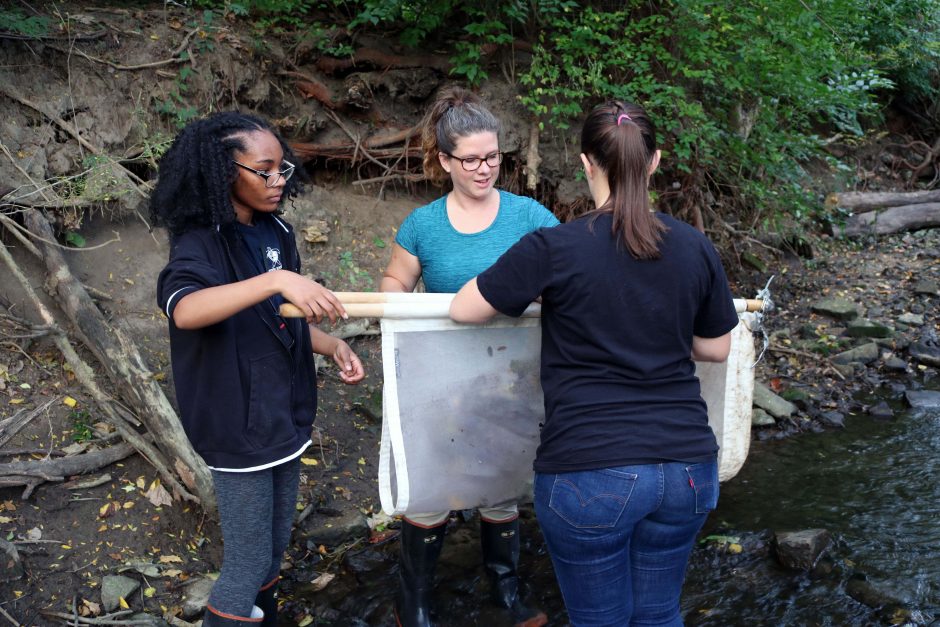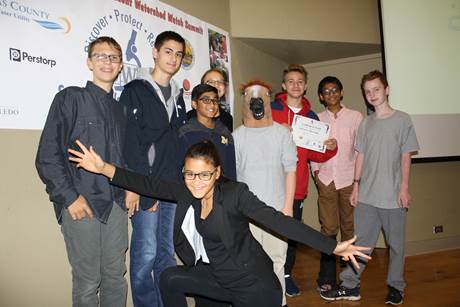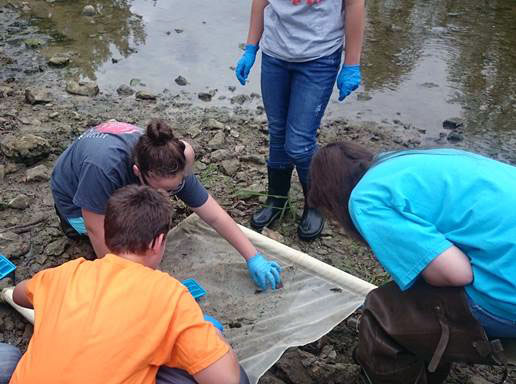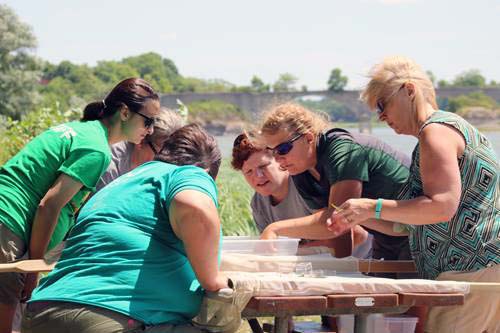TMACOG Program Empowers Teachers to Bring Water Quality to Classrooms

Sara Guiher helping students with a water quality test kit. (Credit: TMACOG)
This summer, teachers across northwest Ohio took the time to learn about water quality in Waterville at Farnsworth Metropark. The teachers were training in the Maumee River for the Student Watershed Watch (SWW) program, run by TMACOG.
“TMACOG is the Toledo Metropolitan Area Council of Governments, Sara Guiher, a water quality planner and SWW coordinator for TMACOG, explains to EM. “We’re a regional planning organization and we work with local governments on issues related to stormwater, wastewater, drinking water, and watersheds. This program started in 1989, and it’s one of our longest running programs.”
The program was designed to foster stewardship through the sampling process. In service to that goal, program teachers show students how to collect water samples from rivers in their communities and measure levels of dissolved oxygen, nutrients, and bacteria in the samples.
“This is the twenty-ninth year for the program, and my second year with the program,” details Guiher. “I actually knew about TMACOG only because I volunteered with this program the year before I started working here.”
This year, nearly 1,000 students throughout the region will be testing the water quality of local rivers and streams at more than 20 sites.
“We do sampling every October, and then every November we have our Student Summit, which is like a mini one-day scientific conference where they get to come in and present their results,” Guiher describes. “They do oral presentations and poster presentations, and speakers present too. The speakers are professionals from environmental fields, and they talk about their career paths, and how they got to be where they are. It’s a really great day.”

One of the winning classes for oral presentations celebrating their victory at the November 2017 Student Summit. (Credit: TMACOG)
Close to home
Teachers in northwest Ohio know that their students have a sense of why water quality matters; it’s part of their daily lives.
“In northwest Ohio, we are right on the waterfront, on Lake Erie,” states Guiher. “We have been having issues with harmful algal blooms since 2011; that was when the first really big one came that we all kind of think back on, where it was clear it was a huge issue. These students have grown up knowing that this is an issue, and they know that nutrients from runoff are the main contributors to those algal blooms. It’s really something that they think about all the time; in 2014 they couldn’t drink their water for three days.”
The SWW program allows students to take a closer look at what causes things like HABs to form, and how they can work to prevent them, by maximizing available resources and taking a practical approach to science.
“A lot of schools have environmental science programs now, or at least classes, especially at the high school level,” Guiher explains. “But often, a lot of schools don’t have funding to do this kind of work, so I’m really glad that we get to provide all of the testing supplies for when they go out and test water quality and they get their students to the rivers. It’s a great way for them to apply this classroom learning in the natural environment.”
SWW provides teachers with a list of parameters that they can choose from as they design experiments for their class.
“Dissolved oxygen, pH, nitrates, and phosphates are the main chemical testing parameters,” comments Guiher. “Aside from the chemical testing, they also look at turbidity, and some schools even take that extra step and look at total solids; this involves drying out the sample and weighing to get those total solids that are in the water. They also calculate stream velocity, and some will record stream characteristics like depth, width, vegetation and other observational details. Then the students measure bacterial levels using Petri films.”
Students also turn over their share of rocks as they assess stream health.
“We also sample benthic macroinvertebrate communities,” states Guiher. “We give teachers nets, sorting trays and microscopes and they’ll look at those communities as an indicator of water quality. They do the counts for the macroinvertebrate communities using a scoring method and then usually they talk about that in their classroom and what the score means.”

Students sorting and identifying aquatic macroinvertebrates. (Credit: TMACOG)
The program doesn’t require all of the parameters from any teacher, to ensure that all willing classes can participate.
“Depending on what their school allows, they might have to sample within a class period, leaving young people as little as 40 minutes to work,” remarks Guiher. “Fortunately, it seems like quite a few of the schools that participate have a stream near enough to walk to, so that helps. Teachers use mostly CHEMets snap kits for chemical testing now, because they’re quick and easy. They come with these little self-filling ampules, which change color depending on the amount of what you’re measuring, so then, you read it using a color wheel for a comparator.”
Scientists for life
Like many citizen science programs, SWW works hard to foster interest and love for science in children. This is part of the reasoning behind the program’s design, which allows students to quickly see the results of their work.
“We don’t send anything out,” explains Guiher. “Obviously the cultures for bacteria take a couple of days, but then they read it as a class to get those counts. We do everything either streamside or in their classroom. We work with students in fifth through 12th grade, so it is a huge age range. For some of the ones at the lower end of the age range, it’s probably their very first experience with stuff like this, actually doing lab work. So it’s nice that they get to be involved with the whole process.”
SWW staff does collect and save the data from the program and make it available to the public, although not all parameters are tested by every student.
“It is a citizen science program, but it’s more about creating future adults that will be stewards of these waterways and that know that things live in there,” clarifies Guiher. “We want the students to learn about how to apply science, and that it’s not just people in lab coats that are doing it.”

Teachers participating in a training to prepare for the fall 2018 Student Watershed Watch. (Credit: TMACOG)
The students get practical experience “doing science,” including presenting their results in a collaborative setting.
“At the Student Summit, they are presenting to a group of their peers just like you do at a conference,” remarks Guiher. “I started presenting my science in my undergrad years, but I hadn’t had experience with that. So to see seventh graders getting up there and talking about dissolved oxygen and what that means to stream community, it’s awesome, and you can tell that they’re getting a lot out of it.”
In fact, some former student participants in SWW have returned as professionals in the industry, just as Guiher returned after volunteering as an adult.
“A few years ago, before my time in the program, they had a speaker who was a professional in an environmental field who had first participated as a student when they were in junior high, who got to come back and present at the summit,” adds Guiher. “So that was that was very cool; I’d love to see that happen more.”
SWW enjoys a tremendous level of community support in Ohio—a factor that has been instrumental in keeping the program thriving.
“This program is completely supported by community sponsors,” emphasizes Guiher. “We have local governments, businesses, and organizations that donate to sponsor the program, some who sponsor it every year. Our partners send representatives to attend our summit because they’re really invested in the program and want to see it succeed. So instead of a logo on the back of a tee shirt or something, the students see actual people that are there, watching their presentations, and working in the field. We have lots of input from people who sample streams professionally and who are passionate about it.”
The coming year will see the SWW celebrating its 30th year, and some bigger events to recognize the program and its importance to so many in the area.
“Last year we had over 500 students that sampled in rivers, and this year we had almost 1,000, so that’s a huge impact,” states Guiher. “It’s really interesting because we have a lot of schools that are in urban areas, and we’re walking down to these streams that they pass over on bridges all the time. Some of them don’t want to touch the water, and they certainly don’t think that anything is living in there. So for them to get out and find aquatic macroinvertebrates, to see life coming out of the stream, that really gets to them. And that’s what we are hoping for. That’s the whole goal of the program.”
Top image: Sara Guiher helping students with a water quality test kit. (Credit: TMACOG)




0 comments